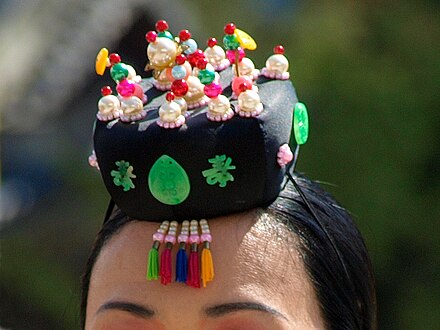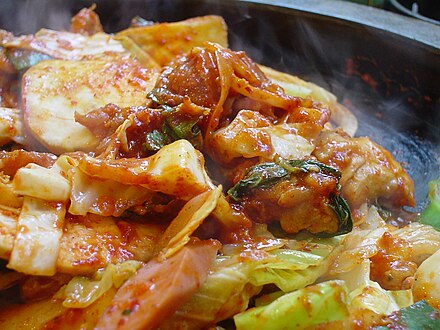Sabías Myojakdo - Cuadro de gatos y gorriones Jeongol de Gopchang Galbitang Wonsam Dangui Hwanbyeokdang Irworobongdo Naksansa Kkachi durumagi Jeogori Jokduri Ayam Dancheong Dak galbi Andong Jjimdak Ganjang gejang Cocina de templo coreana Sodae Nombre de pila Hwajeon Agujjim Baesuk ... que en Corea del Norte , la pregunta "¿Qué tan buena estaba la sopa de trucha se usa como saludo común para quienes regresan de Pyongyang ? el 15 de diciembre de 2009 ... que entre las cocinas regionales coreanas de Kaesong de Corea del Norte se compara con frecuencia con las cocinas de Seúl y Jeolla de Corea del Sur ? el 29 de noviembre de 2009 ... que el contratenor estadounidense Bejun Mehta niño soprano , elogiado por Leonard Bernstein ? el 29 de noviembre de 2009 ... que el pintor coreano del período Joseon , Byeon Sang-byeok , era conocido como "Byeon Cat" debido a su dedicación a las pinturas de gatos como Myojakdo (en la foto) ? el 15 de noviembre de 2009 ... que la pintura coreana del Palacio del Este Gyeongbokgung ? el 15 de octubre de 2009 ... que el templo Geumsansa en Gimje , Corea del Sur , sirvió como campo de entrenamiento para el cuerpo de voluntarios budistas junto con monjes contra las invasiones japonesas de Corea a finales del siglo XVI? el 15 de septiembre de 2009 ... que se cree que el templo Baekryulsa Gyeongju , Corea del Sur , que alguna vez fue la capital del reino de Silla , está asociado con Ichadon , el primer mártir del budismo en Corea ? el 22 de agosto de 2009 ... que en 993, Seo Hui coreano del período Goryeo , impidió una invasión de las tropas Khitan ? el 15 de agosto de 2009 ... that Insadong Seoul consisting of galleries and antique shops, known for "culture of the past and the present"? on July 15, 2009 ... that Gotjawal Forest forest on Jeju Island in South Korea , consists of a rocky area of aa lava ? on June 7 2009 ... that soprano Deborah Voigt gastric bypass surgery after she was fired in the "Covent Garden incident"? on June 3 2009 ... that gopchang jeongol (pictured) , a spicy Korean casserole made by boiling beef tripe , vegetables, and seasonings in beef broth , is a popular dish when drinking alcoholic beverages in South Korea ? on June 2 2009 ... that when the Chinese delicacy Buddha Jumps Over the Wall South Korea , the name ignited a controversy in the Buddhist community ? on 11 May 2009 ... that the Anyangcheon Gyeonggi Province and Seoul City of South Korea , is home to a variety of wildlife such as goldfish , Grey Heron and Northern Shoveler ? on 2 May 2009 ... that Kang Dae-ha Jeju Island of South Korea , directed films related to Korean shamanism and tradition ? on 1 May 2009 ... that galbitang (pictured) , a Korean soup made from beef short ribs called galbi , is a representative dish served at wedding receptions in South Korea ? 26 March 2009 ... that haejangguk Korean guk (soup) consumed as a remedy for hangovers ? 1 March 2009 ... that a wonsam (pictured) was a female ceremonial robe for the queen, royalty, and nobility during the Korean Joseon Dynasty , though commoners could wear it for their wedding? 25 February 2009 ... that during the Korean Joseon period, royal physicians squeezed milk from cows to make tarakjuk porridge , which was served only for the king and royalty? on 23 February 2009 ... that dangui (pictured) was an upper garment worn by the royal women and court ladies for ceremonial occasions during the Korean Joseon Dynasty ? on February 22 2009 ... that Sanggung gungnyeo , a lady-in-waiting during the Joseon Dynasty of Korea ? on 16 February 2009 ... that because of the strict sex segregation of the era based on Confucianism , Korea 's Joseon Dynasty created a class of specialist female physicians known as Uinyeo ... that King Yeongjo of the Korean Joseon Dynasty was said to have been born of a concubine from the musuri ... that gungnyeo Korean term referring to court ladies who waited on the king and royalty during the Goryeo and Joseon dynasties of Korea ? on 10 February 2009 ... that the 500-year-old title Yeonguijeong Joseon Dynasty of Korea , and given to the Chief State Councilor as the highest government position of "Uijeongbu "? on 3 January 2009 ... that Hwanbyeokdang (pictured) , a pavilion in South Korea , is associated with a tale regarding a dragon and 16th century poet Jeong Cheol ? on 7 February 2009 ... that of over 1,000 stone Buddha statues that once existed at the Korean Buddhist temple Unjusa ... that Irworobongdo (pictured) is a Korean folding screen with a stylized landscape painting for symbolizing the political cosmology of the Joseon Dynasty ? on 23 November 2008 ... that an outer jacket, magoja Korea after the king's father, Heungseon Daewongun , returned from Manchuria in 1887? on 8 November 2008 ... that Naksansa (pictured) is a Korean Buddhist temple founded in 671 CE near the place where the Avalokitesvara Bodhisattva is believed to live? on 2008-11-01 ... that a 1989 Samsung commercial began the late South Korean actress Choi Jin-sil ... that the colorful kkachi durumagi (pictured) evokes the good fortune associated with the magpie in Korean folklore ? on 2008-10-07 ... that Korean composer and violinist Hong Nan-pa Bongseonhwa written in 1919 which was widely sung during the Japanese occupation of Korea ? on 2008-10-05 ...... that a jeogori (pictured) is a Korean basic upper garment of traditional hanbok having been worn by both men and women? on 2008-10-05 ... that the Korean traditional winter hat nambawi gold leaf decoration for women? on 2008-09-30 ... that a jobawi Korean traditional winter cap with ear-flaps which was worn by women during the late Joseon Dynasty ? on 2008-09-29 ... that a jokduri (pictured) is a type of Korean traditional coronet worn by women for special occasions such as weddings ? on 2008-09-23 ... that an ayam (pictured) is a Korean traditional winter cap mostly worn by women in the Joseon period ? on 2008-09-22 ... that a Japanese sea spirit named shōjō Kabuki plays?on 2008-09-21 ... that Songpa sandaenori Korean mask play originated in the neighborhoods of Songpa-dong of Seoul , Korea ? on 2008-09-21 ... that dancheong (pictured) refers to Korean traditional decorative coloring on wooden buildings and artifacts for style? on 2008-09-20 ... that memiljeon Korean pancake , made with buckwheat flour and vegetables? on 2008-09-12 ... that the city of Chuncheon , Korea is famous for dak galbi (pictured) , which is made by stir-frying marinated chicken, vegetables, and rice cake in chili pepper paste ? on 2008-09-11] ... that Andong jjimdak (pictured) is a Korean steamed dish originated in the city of Andong ? on 2008-09-11 ... that gejang (pictured) is a variety of jeotgal , fermented seafood in Korean cuisine , which is made by marinating fresh raw crabs in soy sauce ?on 2008-09-10 ... that the beoseon socks worn with hanbok , Korean traditional clothing? on 2008-09-10 ... that white kimchi , Shiitake mushrooms , and rice cakes made with mung beans are elements of Korean temple cuisine (pictured) ?"on 2008-08-15 ... that the Sakuradamon Incident Emperor Hirohito of Japan by a Korean nationalist ? on 2008-08-09 ... that sotdae (pictured) is a tall wooden pole or stone pillar with a sculptured bird atop, traditionally set up for the purpose of folk belief in Korea ? on 2008-07-15 ... that namsadang Korean itinerant troupe during the Joseon Dynasty that performed acrobatics (example pictured) , dancing , and playing like a circus ? on 2008-07-14 ... that Korean writer Park Kyung-ni Land , which has been included in the UNESCO Collection of Representative Works? on 2008-07-13 ... that hwajeon (pictured) is a sweet Korean pancake or rice cake made of edible flower petals , glutinous rice flour , and sugar? on 2008-06-28 ... that although the blackmouth angler is known for its ugly appearance, it is used for making agujjim (pictured) , a popular Korean dish ? on 2008-06-04 ... that in Korean cuisine , dishes made by steaming vegetables such as cucumber , zucchini , or egg plant stuffed with seasoned fillings are called Seon ... that the yuja hwachae Korean traditional fruit punch made with Korean pear and yuja, is often served with flower pancakes made of chrysanthemum ? on 2008-05-30 ... that the baesuk (pictured) is a Korean traditional fruit punch made by simmering slices of Korean pear , black peppercorns , ginger , honey or sugar, and water? on 2008-05-24 ... that Kim Swoo Geun South Korean architect was referred to as "Lorenzo de Medici of Seoul " by Time for his contributions to Korean culture ? on 2008-05-06 ... that the Ilmin Museum of Art South Korea , located on Sejongno , Jongno-gu , central district of Seoul where royal palaces and gates of Joseon dynasty are also situated? on 2008-05-05 ...that kimchi bokkeumbap Korean fried rice made with kimchi and any available ingredients? on 2008-04-11
Contribución
Otras contribuciones Ya se ha publicado. Gracias por tus contribuciones y por pedir ayuda. :) -- candle • wicke 17:34, 23 de mayo de 2009 (UTC)
Premios 




















